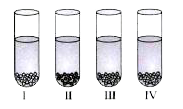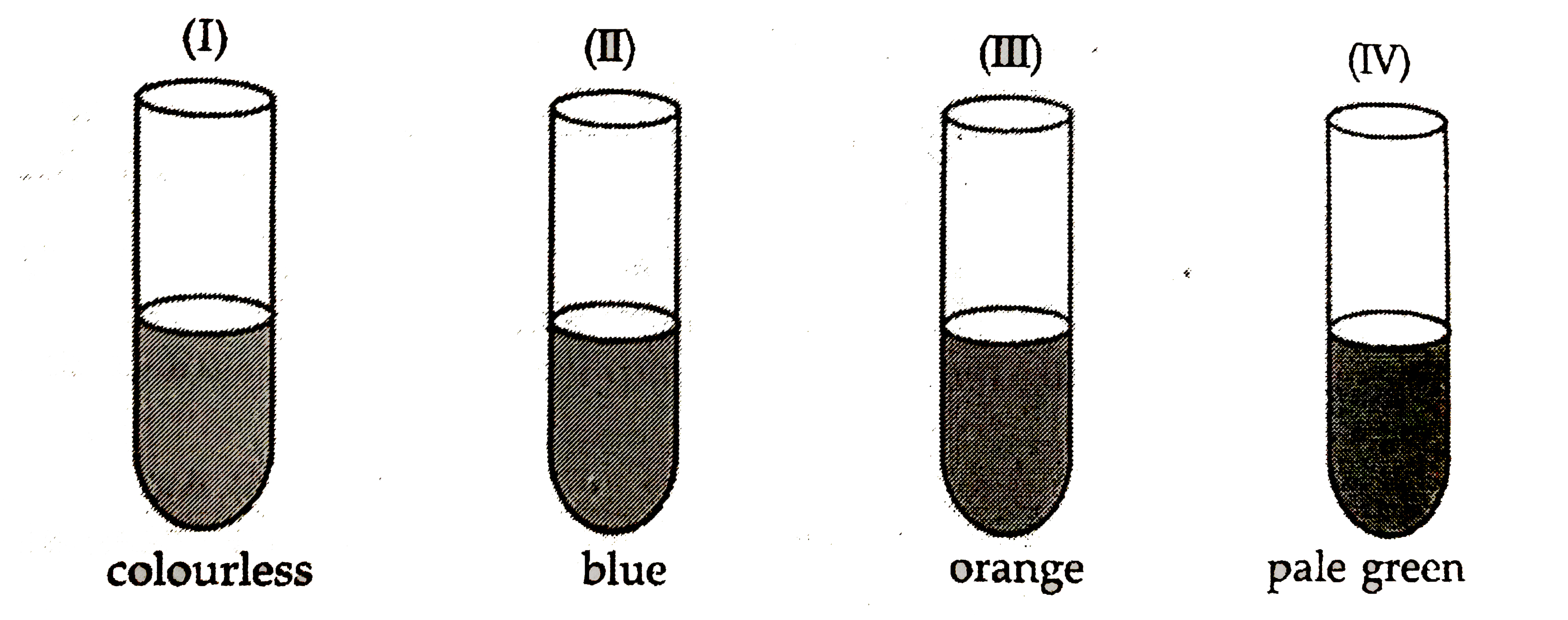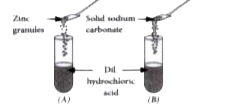Rohan took 10 mL of freshly prepared iron sulphate solution in four different test tubes and added four different metal strips to each test tube as shown below :ln test tubes I and llI black residue was obtained while in test tubes ll and lV no change was observed. Metals P Q R and S could be respectively A Al Cu Pb AsB Pb Cu Ag Al C Zn Al Cu Ag D Zn Cu Al Ag.
Correct option D Zn Cu Al Ag.Explanation:Black residue is obtained in test tubes I and lll i.e. iron gets displaced in test tubes I and lll. Therefore metals P and R should be more reactive than iron.No change is observed in test tubes ll and lV hence metals Q and S should be less reactive than iron.
Related Solutions
Ms. Neelam, a class 10 teacher took Cu, Al, Pb and Zn strips respectively in four test tubes labelled as, I, II, III and IV and added 10 mL of freshly prepared ferrous sulphate solution to each test tube as shown in the figure :

Black residue would be obtained in test tubesView SolutionA student took four test tubes containing solutions of different colours marked I,II, III and IV as shown here. The test tubes containing copper sulphate solution and ferrous sulphate could be the tubes:
 View Solution
View SolutionThree test tubes marked A, B and C are taken. In test tube A copper sulphate solution and iron are added. In test tube B, copper sulphate solution and zinc are added. In test tube C, iron sulphate solution and copper are added. In which test tube will the experimenter observe change and why?
View SolutionA student was studying reactions of metals with dilute NaOH at room temperature. The student took dilute NaOH in four different test tubes and added copper powder to test tube A, zinc dust to test tube B, aluminium powder to test tube C and iron powder to test tube D and observed effervesce in ________.
View SolutionFour different test tubes were filled with aluminium sulphate solution. Different metals were introduced into these test tubes in following manner. What can be inferred ?
View SolutionA student added a piece of zinc metal each to four different test tubes containing different solutions as given below. The test tube in which no reaction was observed, contains
View SolutionFour test tubes were taken and marked A, B, C and D respectively. 2 mL of solution of Al_(2)(SO)_(3) in water was filled in each of the four test-tubes. Clean piece of metal zinc was placed in test tube A, clean iron nail was put in test tube B, clean copper wire was placed in test tube C and a clean aluminium wire was placed in test tube D. What colour change would you observe in all the four tubes ?
View SolutionWhen an aluminium strip is kept immersed in freshly prepared ferrous sulphate solution taken in a test tube, the change which is observed is:
View SolutionA student performed the first set of experiments with four test tubes containing solutions and metal pieces as indicated in the figure. In the second set of experiments, the metal pieces are interchanged between test tubes P and Q and also between test tubes R and S. In which test tube(s), no reaction will occur in both sets of experiments ?
View SolutionA student takes Cu, Al, Fe and Zn piees separtely in four test tubes labelled as I,II, III and IV respectively. He adds 10mL of freshly prepared ferrous sulphate solution to each test tube observes the colour of the metal residue in each case. He would observe a black residue in the test tube:
View Solution5 mL each of concentrated HCl, and a mixture of concentrated (5 mL) were taken in test tubes labelled as A, B and C. A small piece of metal was put in each test tube. No change occurred in test tubes A and B but the metal got dissolved in test tube. The metal could be
View SolutionFour test tubed marked I,II,III and IV were taken 20 ml of solution in water was poured in each of the test tube I, an iron nails was put in test tube II, copper turnings were put in test tube III and a clean aluminium strip was placed in test tube IV. No change was observed in any four any in the test tubes. the correct inference drawn is
View SolutionA student took two test tubes, (A) and (B) containing 2 mL of dilute hydrochloric acid and added zinc granules to test tube (A) and solid sodium carbonate to test tube (B) as shown below:

The correct observation would beView Solution2 mL each of conc. HCl, conc. and a mixture of conc.HCl and in the ratio of 3:1 were taken in test tubes labelled as A, B and C. A small piece of metal was put in each test tube. No change occurred in test tubes A and B but the metal got dissolved in test tube C. the metal could be
View SolutionA student addd few pieces of aluminium metal to two test tubes A and B containing aqueous solutions of iron sulphate and copper sulphate. In the second part of her experiment, the added iron metal to another test tubes C and D containing aqueous solutions of aluminium sulphate and copper sulphate.
In which test tube or test tubes will she observe colour change? On the basis of this experiment, state which one is the most reactive metal and why ?View SolutionPriyanka introduced an iron nail in a test-tube containing freshly prepared copper sulphate solution. What would she observe?
View SolutionPriyanka introduced an iron nail in a test-tube containing freshly prepared copper sulphate solution. What would she observe?
View SolutionMohan takes 5 mL of distilled water in four test tubes A, B, C and D. He dissolves sodium chloride in test tube A, calcium chloride in test tube B, magnesium chloride in test tube C and potassium chloride in test tube D. In which test tube(s) will scum be formed with soap?
View SolutionMohan takes 5 mL of distilled water in four test tubes A, B, C and D. He dissolves sodium chloride in test tube A, calcium chloride in test tube B, magnesium chloride in test tube C and potassium chloride in test tube D. In which test tube(s) will scum be formed with soap?
View SolutionA student addd few pieces of aluminium metal to two test tubes A and B containing aqueous solutions of iron sulphate and copper sulphate. In the second part of her experiment, the added iron metal to another test tubes C and D containing aqueous solutions of aluminium sulphate and copper sulphate. In which test tube or test tubes will she observe colour change? On the basis of this experiment, state which one is the most reactive metal and why ?
View Solution
